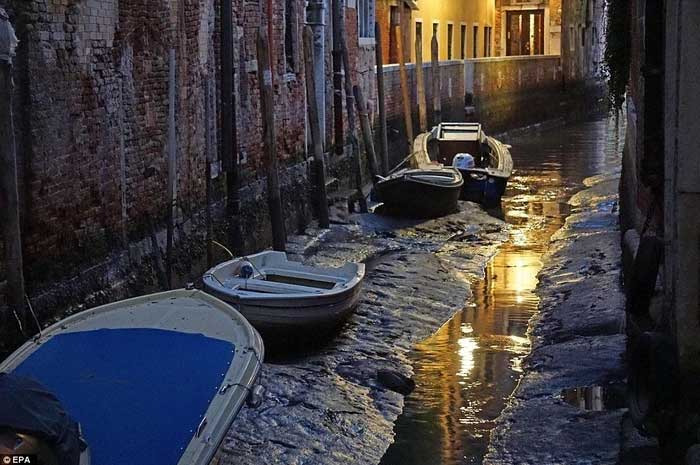Dubbed as the “Most Romantic City in the World,” Venice has become one of the most famous tourist destinations in Italy. With its ancient beauty, unique architecture, winding old streets, and many-windowed narrow houses, it has witnessed countless romantic stories of lovers. This city is also the birthplace of many famous musicians such as Antonio Vivaldi and Giovanni Picchi. Today, Venice is known as a major fashion and shopping hub in Italy.
Particularly, it is called the “Floating City” because Venice has numerous canals and 444 bridges connecting 118 small islands. The houses here are not built directly on the islands but are situated on wooden platforms supported by piles driven deep into the ground.
Using wood as a foundational material may seem unusual, as wood is far less durable than stone or metal. After more than a thousand years, the longevity of the wooden foundations in Venice is indeed remarkable. So, what is their secret?
According to a study published in the journal Science Advances, the technique used by workers lies in the fact that the wooden piles are submerged underwater.
Wood typically decays due to microorganisms like fungi and bacteria. However, the wooden piles supporting Venice’s foundations are submerged underwater, thus avoiding exposure to oxygen, a crucial factor for microbial survival. Additionally, the regular flow of saltwater causes the wood to become petrified over a long period, transforming it into a structure as hard as stone.
This shows that human creativity is limitless. The secret to the longevity of the wooden foundations in Venice rests in the fact that the wooden piles are submerged underwater. Ancient people were incredibly smart in applying a type of “technology” to mitigate the disadvantages of wood, allowing it to stand firm for many years.

Thanks to the surrounding water, Venice has a unique advantage over neighboring cities.
The formation of this dreamy and romantic floating city also has its historical depth. After the fall of the Western Roman Empire, northern invaders flooded into territories that formerly belonged to Rome.
To avoid attacks and bloody warfare, the Venetians fled to the nearby marshlands, finding refuge on the sandy islands of Torcello, Iesolo, and Malamocco.
Initially, the settlement was temporary, but the Venetians gradually established permanent residences on the islands. To create a solid foundation for their homes, the Venetians drove wooden piles into the sandy substrate.
Next, wooden platforms were erected above these piles. Finally, they built houses on the wooden floors. Surrounded by water, Venice had a unique advantage over neighboring cities. It remained safe from enemy invasions and became a powerful city in the Mediterranean.
The city of Venice began to decline in the 15th century, later falling under Napoleon’s rule in 1797.
The inhabitants planned to construct the city after building a dam around the water body. They built the city on marshland surrounded by vast waters. Once completed, the dam was breached, allowing water to flood in, making the city like a fortress amidst the endless sea.
Here, there are no floods, so the water level always remains just at the base of the buildings, at the stone steps leading down to the docks. City residents travel for shopping, work, or visiting each other by boat, either starting the engine or paddling with oars.
Occasionally, there are a few iron bridges connecting one block to another. The steps of high-rise buildings are covered in layers of algae or barnacles and show the colors of time. Almost every house has a boat tied up, gently swaying at the water’s edge.
“Could the Floating City” disappear due to the risk of water shortages?
In recent years, the city of Venice has been facing unusually low tides, making it difficult for iconic features such as gondolas, water taxis, and ambulances to navigate some of the city’s famous canals.
This situation in Venice arises from a combination of several factors, including lack of rain, high-pressure systems, full moons, and ocean currents.
The environmental organization Legambiente has noted that in the northern part of the country, rivers and lakes are experiencing severe water shortages. Notably, the Po River basin, Italy’s longest river flowing from the Alps in the northwest to the Adriatic Sea, has less water than 61% of normal levels at this time of year.

In recent years, the city of Venice has been facing low tides.
The Po basin, which produces about one-third of the nation’s agricultural output, is experiencing the worst drought in 70 years, leading the Italian government to declare a state of emergency for the region last July.
Climate expert Massimiliano Pasqui from Italy’s CNR Scientific Research Institute stated in the newspaper Corriere della Sera: “We have been in a state of increasing water shortage since the winter of 2020-2021.”
“We need to recover 500mm in the Northwest areas. We need 50 days of rain,” he said.
An open walkway might be used to reach the small island of San Biagio on Lake Garda in northern Italy, where water levels have dropped to record lows.


















































